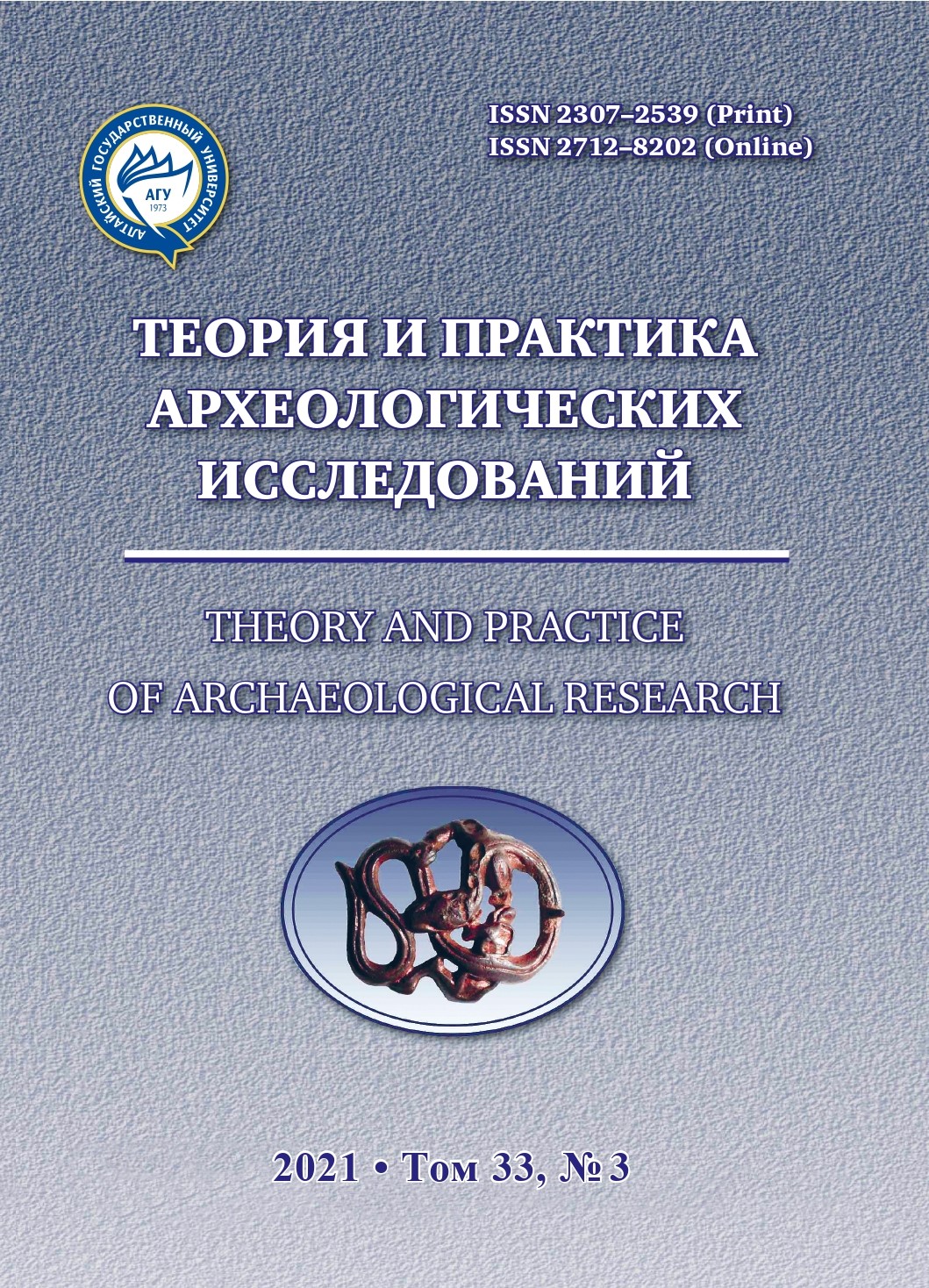ADVANTAGES OF SCAR-PATTERN ANALYSIS IN THE STUDY OF PALEOLITHIC СORES
Abstract
Scar-pattern or working step analysis is one of the main components of technological analysis. This analysis is usually applied to reconstruct the technological sequence of Middle and Upper Palaeolithic bifacial tools. In addition to bifacial implements, the scar-pattern analysis is applied to geometric microliths and to macro-implements made on large flakes, such as Quina scrapers. However, the potential of this analysis is much wider. Here we present the basic approaches and algorithm for the application of scar-pattern analysis to core analysis.
The analysis algorithm includes five main research activities: determining the directions of all negatives, determining the mutual sequence of adjacent negatives, combining negatives into “technological units”, determining the mutual consistency of the groups of combined negatives and complicating of scheme. As an example, two carinated technological sequences in the Kulbulakian from Western Central Asia are provided. Scar-pattern analysis applied to reconstruct the technological sequences of the cores is devoid of the disadvantages inherent in this analysis applied to bifacial tools. We believe that scar-pattern analysis is the most promising in Paleolithic technological reconstructions.
Downloads
Metrics
References
Bar-Yosef O., Van Peer P. The Chaine Operatoire Approach in Middle Paleolithic Archaeology. Current Anthropology. 2009. № 1 (50). Рp. 103–131.
Boёda E. Determination des unitйs techno-fonctionnelles des piиces bifaciales provenant de la couche acheulйenne C’3 base du site de Barbas I // Les industries а outils bifaciaux du Paléolithique moyen d’Europe occidentale. Liиge : Editions de l’Universitй de Liиge 2001. Pp. 51–75.
Boёda E., Geneste J. M., Meignen L. Identification de сhaine opйratoires lithiques du Paléolithique ancien et moyen // Paléo. 1990. № 2. Рp. 43–80. Chabai V. P. Srednij paleolit Kryma [Middle Paleolithic of Crimea]. Simferopol : Shlyah, 2004. 324 p. (In Russ.)
Clarkson C., Vinicius L., Lahr M. M. Quantifying Flake Scar Patterning on Cores Using 3D Recording Techniques // Journal of Archaeological Science. 2006. № 33. Pp. 132–142.
Girya E. Yu. Tehnologicheskij analiz kamennyh industrij: Metodika mikro-makroanaliza drevnih orudij truda. Ch. 2 [Technological Analysis of Stone Industries (Methodology of micro-macroanalysis of Ancient Tools, Part 2). Sankt-Peterburg : Izd-vo IIMK RAN, 1997. С. 199 (In Russ.)
Doronichev V. B. Izuchenie tehniki rasshchepleniya nukleusov kak sistemy vzaimosvyazannyh teknologicheskih processov (po materialam Abadzehskogo mestonahozhdeniya v Majkopskom rajone) [Studying the Technique of Splitting Cores as a System of Interrelated Technological Processes (based on materials from the Abadzekh site in the Maikop region)]. Voprosy arheologii Adygei. [Questions of Archaeology of Adygea]. Majkop : Adygejskoe knizhnoe izdatel’stvo, 1986. Pp. 79–92 (In Russ.)
Inizan M. L., Reduron-Ballinger M., Roche G., Tixier J. Technology and Terminology of Knapped Stone. Translated by J. Fйblot-Augustins. Prйhistoire de la Pierre Taillйe T. 5. Nanterre : CREP, 1999. P. 189
Jцris O. Neue Untersuchungen zum Mittelpalдolithikum von Buhlen, Hessen. Technologische Studien zur Pradniktechnik in Horizont IIIb des Oberen Fundplatzes // Ethnographisch Archдologische Zeitschrift. 1994. № 35. Рp. 88–97.
Jцris O. Bifacially backed knives (Keilmesser) in the Central European Middle Palaeolithic // Axe age: Acheulian Tool-Making from Quarry to Discard / eds. by N. Goren-Inbar, G. Sharon. London, 2006. Pp. 287–310.
Kolobova K. A. Priemy oformleniya kamennyh orudij v paleoliticheskih industriyah Gornogo Altaya [Techniques for the Formation of Stone Tools in the Paleolithic Industries of Gorny Altai]. Novosibirsk : Izd-vo In-ta arheologii i etnografii SO RAN, 2006. (In Russ.)
Kolobova K. A., Krivoshapkin A. I., Shnaider S. V. Early Geometric Microlith Technology In Central Asia // Archaeological and Anthropological Sciences. 2018. №1. DOI: 10.1007/s12520-018-0613-y
Kolobova K. A., Shalagina A. V., Chistyakov P. V., Bocharova E. N., Krivoshapkin A. I. Threedimensional Modelling Application for Studying Stone Age Assemblages // Siberian Historical Research. 2020. № 4. Pp. 240–260. DOI: 10.17223/2312461X/30/12
Kot M. A. The Earliest Middle Palaeolithic Bifacial Leafpoints in Central and Southern Europe. Technological Approach. PhD Thesis. Warsaw. 2013. Р. 374
Kot M. A. The Earliest Middle Palaeolithic Bifacial Leafpoints in Central and Southern Europe: Technological Approach // Quaternary International. 2014. № 326–327. Р. 381–397. DOI: 10.1016/j.quaint.2013.10.030
Lemorini С., Bourguignon L., Zupancich A., Gopher A., Barkai R. A Scraper’s Life History: Morpho-Techno-Functional and Use-Wear Analysis of Quina and Demi-Quina Scrapers from Qesem Cave, Israel // Quaternary International. 2015. № 398. Рp. 1–8.
Lyubin V. P. K voprosu o metodike izucheniya nizhnepaleoliticheskih kamennyh orudij [On the Question of the Method of Studying the Lower Paleolithic Stone Tools]. Paleolit I neolit SSSR [Paleolithic and Neolithic of the USSR]. Vol. V. Moscow; Leningrad : Nauka, 1965. Pp. 7–75 (In Russ.)
Nehoroshev P. E. Tehnologicheskij metod izucheniya pervichnogo rasshchepleniya kamnya srednego paleolita [Technological Method for Studying the Primary Cleavage of the Middle Paleolithic Stone]. Sankt-Peterburg : Evropeiskij dom, 1999. P. 172. (In Russ.)
Neruda P. Blank Length Reconstruction on the Base of Circular Segment Method –Core Refitting Case Study // Anthropologie (Brno). 2015. № 53 (3). Рp. 531–545.
Nerudova Z., Neruda P. Technology of Moravian Early Szeletian Leaf Point Shaping: A Case Study of Refittings from Moravský Krumlov IV Open-Air Site (Czech Republic) // Quaternary International. 2017. № 428. Рp. 91–108. DOI: 10.1016/j.quaint.2015.09.065
Ocherednoj A. K. Sistemy skalyvaniya v analize izgotovleniya dvustoronneobrabotannyh orudij [Chipping Systems in the Analysis of the Manufacture of Double-Sided Tools]. Trudy istoricheskogo fakul’teta Sankt-Peterburgskogo universiteta [Proceedings of the Faculty of History of St. Petersburg University]. 2014. № 18. Рp. 215–224. (In Russ.)
Pastoors A. Standardization and Individuality in the Production Process of Bifacial Tools — Leaf-Shaped Scrapers from the Middle Paleolithic Open Air Site Sare Kaya I (Crimea). In Neanderthals and Modern Humans — Discussing the Transition. Central and Eastern Europe from 50.000–30.000 B. P. Mettmann : Neanderthal Museum, 2000. Рp. 243–255.
Pastoors A., Schafer J. Analyse des йtats techniques de transformation d’utilisation et états post dépositionnels. Illustrée par un outil bifacial de Salzgitter-Lebenstedt (FRG) // Préhistoire Européenne. 1999. № 14. Рp. 33–47.
Pavlenok G. D., Kozlikin M. B., Shunkov M. V. Small Blade Technology in the Early Upper Paleolithic Industries from Denisova Cave: Data from Analysis of a Lithic Reduction Sequence // Ural’skij Istoriceskij Vestnik. 2021. № 70 (1). Pp. 123–128
Pavlenok K. K., Belousova N. E., Rybin E. P. Atributivnyj podhod k rekonstrukcii “operacionnyh cepochek” rasshchepleniya kamnya [An Attributive Approach to the Reconstruction of “Operational Chains” of Stone Splitting]. Vestnik Novosibirskogo gosudarstvennogo universiteta. Ser.: Istoriya, filologiya [Bulletin of Novosibirsk State University Series: History, Philology]. 2011. Vol. 10. Issue 3. 2011. P. 35–46. (In Russ.)
Pavlenok G., Pavlenok K. Scar-Pattern Analysis of the Bladelet Cores from Layer 23 of Kulbulak Site // The Past has a Future! Conference to Mark the Centenary of Archaeology at the Institute of Archaeology, University of Warsaw (9–3.12.2019). Warsaw, 2019. Pp. 61–62.
Pelegrin J. Prehistoric Lithic Technology: Some Aspects of Research // Archaeological Review from Cambridge. 1990. № 9. Рp. 116–125.
Pigeot N. Reflexions sur l’histoire technique de l’homme: De l’evolution cognitive a l’evolution culturelle // Paleo 1991. № 3. Рp. 167–200.
Richter J. Une analyse standarisée des chaines opératoires sur les pièces foliacées du Paleolithique moyen tardif // L. Bourgignon, I. Ortega and M.‑C. Frèresautot (eds). Préhistoire et approche expérimentale. 2001. Рp. 77–78.
Richter J. Copies of flakes: Operational Sequences of Foliate Pieces from Buran-Kaya III Level B1 // V. P. Chabai, K. Monigal and A. E. Marks (eds.). The Middle Paleolithic and Early Upper Paleolithic of Eastern Crimea 3. Liege : ERAUL 104, 2004. Рp. 233–247.
Shalagina A. V., Kharevich V. M., Maury S., Baumann M., Krivoshapkin A. I., Kolobova K. A. Reconstruction of the Bifacial Technological Sequence in Chagyrskaya Cave Assemblage // Siberian Historical Research. 2020. № 3. Рp. 130–151. DOI: 10.17223/2312461X/29/9
Shalagina, A., Kolobova, K., Krivoshapkin, A. Scar Pattern Analysis as a Method for the Rreconstruction of Lithic Artifacts Production Sequence // Stratum Plus. 2019. № 1. Рp. 145–154.
Shalagina A. V., Krivoshapkin A. I., Kolobova K. A. Truncated-Faceted Pieces in the Paleolithic of Nothern Asia. Archaeology, Ethnology & Anthropology of Eurasia. 2015. № 4(44). Р. 33–45. DOI: 10.17746/1563-0102.2015.43.4.033-045
Soriano S., Villa P. Early Levallois and the Beginning of the Middle Paleolithic in Central Italy // PLoS One. 2017. № 12(10). e0186082. DOI:10.1371/journal.pone.0186082.
Scheer A.‑W. ARIS — Modellierungsmethoden, Metamodelle, Anwendungen. Berlin Heidelberg : Springer-Verlag. 1998. DOI 10.1007/978-3-642-97731-2
Soriano S., Villa P., Delagnes A., Degano I., Pollarolo L., Lucejko J. J., Henshilwood Ch., Wadley L. The Still Bay and Howiesons Poort at Sibudu and Blombos: Understanding Middle Stone Age Technologies // PloS ONE. 2015. № 10 (7). Р. 1–46.
Uthmeier Th. The Transition from Middle- to Upper Palaeolithic at Buran Kaya III, Crimea (Ukraine): a Case of Conceptual Continuity of Lithic Artefact Manufacture?» // A. Pastoors and M. Peresani (eds.). Flakes not Blades: The Role of Flake Production at the Onset of the Upper Palaeolithic. Mettmann: Wissenschaftliche Schriften des Neanderthal Museums 5, 2012. Рp. 239–260.
Uthmeier Th. Transformation Analysis and the Reconstruction of On-Site and Off-Site Activities: Methodological Remarks // V.P. Chabai, K. Monigal and A.E. Marks (eds.): The Middle Paleolithic and Early Upper Paleolithic of Eastern Crimea: The Paleolithic of Crimea III. Liege : ERAUL 104, 2004. Рp. 175–191.
Veselsky A. P. Kabazi V: Production and Rejuvenation of Bifacial Tools // Kabazi V: Interstratification of Micoquian & Levallois-Mousterian Camp Sites. Palaeolithic Sites of Crimea. Vol. 3, Part 2. Simferopol; Cologne : Shlyakh, 2008. Pp. 455–479.
Wiśniewski A., Chłoń M., Weiss M., Pyżewicz K. Migal W. On Making of Micoquian Bifacial Backed Tools at Pietraszyn 49a, SW Poland // Journal of Paleolithic Archaeology. 2020. №3. Рp. 856–888.
Zwyns N. Laminar Technology and the Onset of the Upper Paleolithic in the Altai, Siberia (Studies in Human Evolution). Doctoral Thesis, Leiden : University Press. 2012. P. 414.
Theory and Practice of Archaeological Research is a golden publisher, as we allow self-archiving, but most importantly we are fully transparent about your rights.
Authors may present and discuss their findings ahead of publication: at biological or scientific conferences, on preprint servers, in public databases, and in blogs, wikis, tweets, and other informal communication channels.
Theory and Practice of Archaeological Research allows authors to deposit manuscripts (currently under review or those for intended submission to ABS) in non-commercial, pre-print servers such as ArXiv.
Authors who publish with this journal agree to the following terms:
- Authors retain copyright and grant the journal right of first publication with the work simultaneously licensed under a Creative Commons Attribution License (CC BY 4.0) that allows others to share the work with an acknowledgement of the work's authorship and initial publication in this journal.
- Authors are able to enter into separate, additional contractual arrangements for the non-exclusive distribution of the journal's published version of the work (e.g., post it to an institutional repository or publish it in a book), with an acknowledgement of its initial publication in this journal.
- Authors are permitted and encouraged to post their work online (e.g., in institutional repositories or on their website) prior to and during the submission process, as it can lead to productive exchanges, as well as earlier and greater citation of published work (See The Effect of Open Access).








2.jpg)



